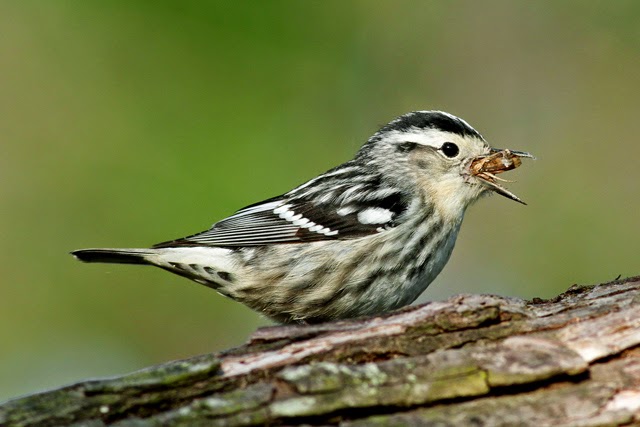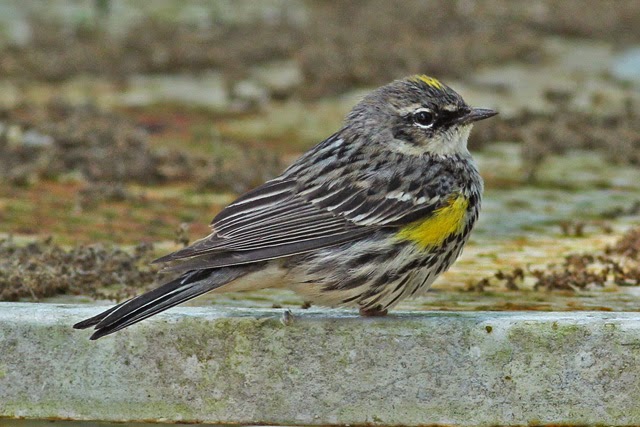This was one of the hardest blog posts to put together. Ranking all of the wonderful American wood-warblers. I contemplated just posting a load of photos and saying how fantastic they all were - because they were - but I wanted to challenge my own thought process of what genuinely makes me appreciate a bird. Colour, character, abundance and prior desire to see it all certainly came into play. And given that (nearly) each and every one of the 35 American wood-warblers I saw in Texas last month was a) colourful b) showed well and c) would make a year in a British context, this was going to be a hard call. So I'll give it a try here and I'd be interested to hear what you think...
1. Yellow-throated Warbler - close encounters with a stunning male on breeding territory in riverine vegetation was a complete experience. A handful seen in total, so scarce (as it's one of the earliest migrants on the coast).
2. Blackburnian Warbler - three seen in total, including a showy male on High Island. Lives up to all the hype for once. Just need one in the WP now!
3. Golden-cheeked Warbler - a restricted range species, full of contrast and one male in particular showed well in the dry woods of the hills surrounding San Antonio.
4. Nashville Warbler - diminutive and seriously under-rated. I loved these little chaps - with their eyering, a subtle cinnamon dusting to the crown with a high-pitched metallic call - and despite being relatively common on a couple of days, loved each and every one I saw!
5. Hooded Warbler- an inquisitive dash of yellow in the darkness. A real lover of the dark understorey, and despite being common, always a pleasure... and look forward to the day I see one in one of those ribeiras on Corvo.
6. Kentucky Warbler - bouncing about on woodland floors (so a complete pain to photograph), nice and distinctive with several seen, but not enough to lose their value.
7. Black-throated Green Warbler - regular in small numbers at coastal sites, and the males are smart, contrasting things. Often needed to crane my neck up to see them - just like the one on Corvo last autumn - but worth the effort on every occasion.
8. Blue-winged Warbler - bold and brash, often vocal. Every one I saw brought back memories of that manic day on Cape Clear back in early October 2000.
9. Golden-winged Warbler - having only seen this quality species in Costa Rica a decade ago, it was nice to see a few on migration at High Island. Lovely birds, intricate and showy too.
10. Cerulean Warbler - quite regal really, with not a splash of colours but with intricacy winning over. At least half a dozen seen on the trip, so a good tally for this relatively scarce species.
11. Canada Warbler - one lovely, showy bird seen on High Island. Vivid colours, bubblegum legs and once again, the memories of the only one I'd ever seen before this - on a windswept Irish headland - came flooding back.
12. Colima Warbler - any bird you're going to walk ten or so miles for must be worth it. And it was; not one of the most colourful of the family but the close views that one bird gave meant it has got to be ranked highly.
13. Palm Warbler - much better than you'd imagine given the hard time I've heard this species get. It wasn't the first time either that I've enjoyed this species, following a showy bird in California last year. Continually tail-bobbing too added to the character.
14. Prothonotary Warbler - bold and bright. Seen as a migrant and on breeding territory. The gloss taken off this species by seeing one get hit by a car on breeding grounds, and having to dispose of the body.
15. Northern Parula - common, colourful and always a delight. If it was rare, it'd be much higher up but guess you can have too much of a good thing?
16. Black-and-white Warbler - like the species above, seen virtually daily and in good numbers. A mint humbug clambering up and down trees.
17. Prairie Warbler - seen only on breeding territory just as a thunderstorm passed over. May have ranked higher up if the sun had been shining.
18. Townsend's Warbler - only seen at Big Bend on the Colima Warbler hike, but having seen this species fairly often in California and Washington the last couple of years, perhaps its stunning plumage is something that I now take for granted too much?
19. Wilson's Warbler - just a couple seen in Big Bend, and like the species above, it's a bird I've seen a lot of in recent years. Of course this includes one on Dursey Island, Cork last September :)
20. Worm-eating Warbler - just a couple seen, and both were elusive. Sturdy and distinctive - perhaps if I'd have had one crawling around me then it'd have been ranked higher, but pretty special birds all the same.
21. Yellow-breasted Chat - this pseudo-warbler is admittedly pretty smart, and I feel slightly ashamed to rank it in the bottom half. Perhaps as it's a little bit more sluggish that the true warblers reduces its appearance somewhat.
22. Chestnut-sided Warbler - just a little bit too much going on with the adults. Having seen juveniles in New England over a decade or so, they're much more my cup of tea. The two adults I saw in Texas were still smart though.
23. Blackpoll Warbler - one seen on High Island. A large warbler, and nice to see an adult as opposed to the few transatlantic first-winters I'm more used to seeing.
24. Painted Redstart - perhaps you can overdo it? So gaudy with its black and red plumage, just the one bird seen in Boot Springs, Big Bend.
25. American Redstart - like several of these species, I can't believe that it has to be ranked so low. However, I guess some birds just get you going more than others and having seen a lot of them on past trips to the northeast of the US in summer, perhaps this has an impact.
26. Swainson's Warbler - two birds seen, and both extremely elusive. One singing male at Big Thicket did eventually show nice enough, but with the camera back in the car.
27. Ovenbird - several seen as migrants, skulking in the undergrowth on High Island and Sabine Woods. Characterful, though like a few other species, I've seen a fair few previously including on Scilly and the Azores.
28. Louisiana Waterthrush - enjoyed seeing this species, as particularly in the early part of the trip it was the only waterthrush on migration.
29. Northern Waterthrush - just the one bird seen, by the grandstand on High Island. Having seen several previously, I suppose that's why I ranked it below the above species.
30. Tennessee Warbler - a common sight on most days, flitting about and calling frequently. Nice to see so many.
31. Common Yellowthroat - commonly seen, and certainly being numerous does devalue the males which are a pretty stunning bird.
32. Yellow-rumped Warbler - having visited California the last couple of winters, I had probably had enough of a good thing. Once again, this species (Myrtle on the coast and Audubon's at Big Bend) was numerous.
33. Pine Warbler - encountered only on breeding territory in forests where I'd been targetting other species so essentially a sideshow. And all seen were high up in relatively poor light unfortunately.
34. Orange-crowned Warbler - the closest you get to the warblers we're used to over in Europe. But still, with its harsh call and yellowish undertail, pretty distinctive and seen in decent numbers particularly early in the trip.
35. Lucy's Warbler - after almost giving up in the wind and intense heat, a pair were found by the Rio Grande in Big Bend. Non-descript and being blown about, and not behaving too well for photography.



























Hi Rich - would agree with your top 3 being right up there, but would also put Ovenbird right up there as well, just for character & their feeding habit. Also would have American Redstart near the top. 2 birds I've never tired of seeing in the New World.
ReplyDeleteSteve Smith
BirdingPooleHarbourandBeyond.blogspot.co.uk
Cheers Steve, it's a tricky business for sure and I reckon that if I composed the list again, it wouldn't be in the same order. I think the reason that Ovenbirds frustrated me with tantalising photographic opportunities (that I failed to take) immediately put them in my bad books!
ReplyDeleteJust back from a family week in Canada and saw a good few of these. With Steve on the Ovenbird, watched one creeping along a branch at head height with the crown raised, just stunning. Have to say though, my warbler-of-the-week had to be Magnolia. Saw a few and they just have it all, yellow, blue, grey, white, streaks etc, a real vision. Closely followed by Blackburnian, Cape May, Bay-breasted and Canada. Real jewels.
ReplyDelete